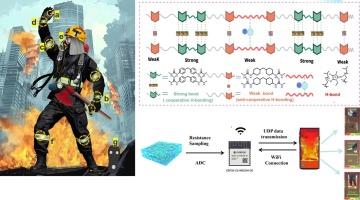Deep learning-enhanced wear-resistant antimicrobial polyurea-based ionogels for real-time firefighter motion tracking in extreme environments
IF 13.2
1区 工程技术
Q1 ENGINEERING, CHEMICAL
引用次数: 0
Abstract
Flexible sensors are critical for monitoring the vital signs of firefighters but face substantial challenges in urgent scenarios (e.g., emergency rescues), including mechanical damage, biofouling, and high-temperature instability. To address these issues, we developed a polyurea-based ionogel (Pub-xIL) via a catalyst-free ambient synthesis strategy, in which ionic liquids are incorporated into polyurea matrices. By tuning molecular ratios (PPG2000/PPG400 and MDI/HMDI), hierarchical H-bond networks were engineered, endowing Pub-xIL with exceptional mechanical properties: tensile strength of 1.7 MPa, puncture resistance (6.95 N load capacity), tear resistance (fracture energy = 2989 J/m2), and self-healing properties. Standardized quantitative wear resistance analysis showed that Pub-xIL had a wear index of 0.046 mg/cycle, outperforming traditional flexible sensor substrates such as polydimethylsiloxane, polyimide, and polyethylene terephthalate. Additionally, Pub-xIL maintained stable performance across a broad temperature range (−20 to 60 °C). The functional ionic liquid [EMIM][TFSI] confers dual advantages on Pub-xIL: it achieves >99 % inhibition rates against Staphylococcus aureus and Escherichia coli and yields a high strain coefficient (GF = 3.79, enabling precise motion detection). Integrating the Pub-xIL sensor array with machine learning algorithms enabled real-time classification of dynamic movements (e.g., walking, running) and static postures (e.g., standing, lying down) with a classification accuracy over 96 %. This work enhances situational awareness and survival prospects in life-critical rescue missions, while establishing a pioneering platform for next-generation firefighting wearable systems.

深度学习增强的耐磨抗菌聚氨酯离子凝胶,用于在极端环境中实时跟踪消防员的运动
柔性传感器对于监测消防员的生命体征至关重要,但在紧急情况下(例如紧急救援)面临重大挑战,包括机械损伤、生物污染和高温不稳定。为了解决这些问题,我们通过无催化剂环境合成策略开发了一种基于聚脲的离子凝胶(Pub-xIL),其中离子液体被纳入聚脲基质中。通过调节分子比(PPG2000/PPG400和MDI/HMDI),构建了层次式氢键网络,使Pub-xIL具有优异的力学性能:抗拉强度为1.7 MPa,抗刺穿(6.95 N载荷能力),抗撕裂(断裂能 = 2989 J/m2)和自愈性能。标准化的定量耐磨性分析表明,publ - xil的磨损指数为0.046 mg/cycle,优于传统的柔性传感器衬底,如聚二甲基硅氧烷、聚酰亚胺和聚对苯二甲酸乙二醇酯。此外,Pub-xIL在较宽的温度范围内(- 20至60 °C)保持稳定的性能。功能离子液体[EMIM][TFSI]对Pub-xIL具有双重优势:对金黄色葡萄球菌和大肠杆菌的抑制率达到>;99 %,并且产生高的菌株系数(GF = 3.79,可以实现精确的运动检测)。将Pub-xIL传感器阵列与机器学习算法集成在一起,可以对动态运动(例如步行、跑步)和静态姿势(例如站立、躺下)进行实时分类,分类精度超过96% %。这项工作增强了在生命攸关的救援任务中的态势感知和生存前景,同时为下一代消防可穿戴系统建立了一个开创性的平台。
本文章由计算机程序翻译,如有差异,请以英文原文为准。
求助全文
约1分钟内获得全文
求助全文
来源期刊

Chemical Engineering Journal
工程技术-工程:化工
CiteScore
21.70
自引率
9.30%
发文量
6781
审稿时长
2.4 months
期刊介绍:
The Chemical Engineering Journal is an international research journal that invites contributions of original and novel fundamental research. It aims to provide an international platform for presenting original fundamental research, interpretative reviews, and discussions on new developments in chemical engineering. The journal welcomes papers that describe novel theory and its practical application, as well as those that demonstrate the transfer of techniques from other disciplines. It also welcomes reports on carefully conducted experimental work that is soundly interpreted. The main focus of the journal is on original and rigorous research results that have broad significance. The Catalysis section within the Chemical Engineering Journal focuses specifically on Experimental and Theoretical studies in the fields of heterogeneous catalysis, molecular catalysis, and biocatalysis. These studies have industrial impact on various sectors such as chemicals, energy, materials, foods, healthcare, and environmental protection.
 求助内容:
求助内容: 应助结果提醒方式:
应助结果提醒方式:


